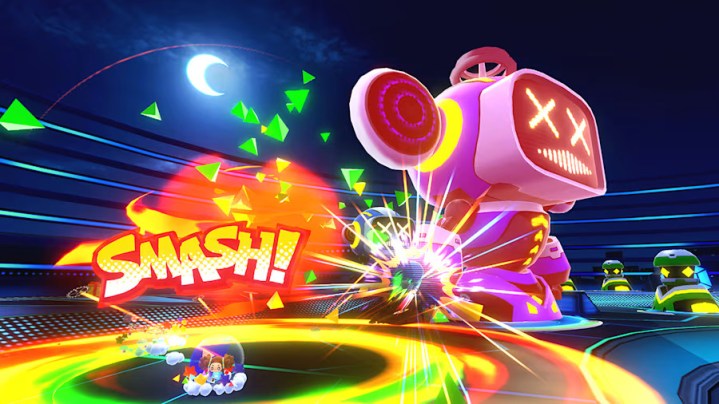Super Monkey Ball: Banana Rumble
MSRP $50.00
Pros
- Fast, tense gameplay
- Diverse stages
- Spin dash is a revelation
- Rewarding progression
- Great accessibility options
Cons
- Camera can be a pain
- Limited multiplayer modes
As I grunted and contorted my body while trying to clear a difficult level in Super Monkey Ball Banana Rumble, my girlfriend turned to me with a bit of concern. “This doesn’t seem fun,” she said. I tried to explain why I was actually having a blast, summarizing Super Monkey Ball’s cross-genre appeal as a platformer, puzzle game, and speedy racing game. As hard as I tried, I couldn’t quite put that appeal into words. That is, until moments later when I completely bypassed the entire level I was stuck on by speed boosting on top of a spiraling maze instead of rolling around it and carefully ricocheting myself into the goal — all in mere seconds.
The triumphant scream that ensued got the point across much clearer.
The joy of Sega’s Super Monkey Ball series has always been the way it sits perfectly balanced on a razor’s edge. At its best, it encourages players to carefully roll through narrow mazes in one moment, then dares them to courageously barrel through them like Evel Knievel in the same breath. It’s been a long time since a Monkey Ball game has delivered that specific bliss, but Banana Rumble finally brings the energy back in a robust package built for casual fans and high-level speedrunners alike.
Need for speed
Rather than reinventing the ball, Banana Rumble doubles down on the core formula that’s made its earliest entries enduring classics. Playing as a monkey (or hedgehog) in a ball, players carefully roll around obstacle courses filled with narrow turns, hole-filled floors, and more devilish hazards en route to a goal. Each level has a 60-second timer, so the trick is knowing when it’s safe to slow down to take a hard hurdle carefully or rocket forward as fast as possible to make up for lost time. That tension has always been the heart of Super Monkey Ball and Banana Rumble delivers plenty of palm-sweating fun.
Part of that success is thanks to strong stage design. The core experience lies in Adventure Mode, a spirited campaign that features a charming cartoon story, full cutscenes, and a colorful cast of characters. The presentation goes a long way toward making Banana Rumble feel like a high-effort offering, and that’s even more apparent in the 200 stages it offers (100 main stages and 100 bonus levels). Rather than taking a few good gimmicks and escalating them in each 10-level world, Like a Dragon developer Ryu Ga Gotoku throws as many ideas out as it can to keep players guessing. One minute I’m navigating a puzzling hedge maze that tests my spatial reasoning. Moments later, I’m zooming down a straight path like a skateboarder, using ramps to gain more speed while avoiding bumpers and floor holes, all within six seconds. Every time I start a stage, it’s like I’m pulling a gachapon; I don’t know what I’ll get.

Naturally, some ideas are better than others. The best ones tend to be short challenges that can be cleared in no time once I execute some perfect movement or deduce some time-saving shortcuts. I feel like an engineer when I realize I can skip an entire twisty stage by simply launching off a rising platform and using it as a jump to hop straight to a far-off goal. That momentum occasionally slows in longer, platforming-focused levels where I have to carefully tightrope walk through narrow paths. A finicky third-person camera especially dampens less forgiving levels that require precision rather than creative thinking. Thankfully, developer Ryu Ga Gotoku paces its diverse levels out well, being careful not to string momentum-killing ones together.
That’s all familiar fun, but Banana Rumble has a secret weapon: the spin dash. Pulled straight from Sonic’s playbook, the new technique allows players to charge up a boost to get a little extra speed while rolling. That small feature cracks the Super Monkey Ball formula wide open. While I’ve always enjoyed playing myself, I’ve much preferred to watch speedrunners tear it apart over the years. It’s a thrilling spectator sport, as skilled players manipulate physics to clear levels in the blink of an eye. I never thought I could pull that off myself until now.
It’s a Cirque du Soleil show where I’m every performer.
The spin dash makes speedrunning even more approachable, as it allows me to experiment with my own shortcuts. I already have a folder full of replays that I keep watching in awe of what I pulled off. One cleverly themed level lays out a cyclone of bowls. Players would usually have to slowly drop themselves into adjacent ones until they reach the goal housed in a spinning plate. In one of my proudest recorded clips, I instead wait a second before launching over the lip of the first bowl with a slight dash. The timing, combined with some careful air control, works out so I fall right through the goal at exactly the right time — a four-second feat.
Daredevil moments like that make Banana Rumble feel special. It has the brainy problem-solving of a puzzle game, the careful precision of a tight platformer, and the execution-heavy thrill of a lightning-fast action game like Katana Zero. It’s a Cirque du Soleil show where I’m every performer.
16-player rumbles
One of the big hooks this time is a robust collection of multiplayer options, both locally and online. In addition to co-op play in Adventure mode, Banana Rumble features five party-focused multiplayer modes that support up to 16 players. They’re more bite-sized minigames than anything, but there’s some light creativity to be found there.

The cream of the crop is Goal Rush, where players split into two teams placed at the top of a descending slope covered in goals with different point values. The goal is for each team to rack up as many points as possible in two minutes, with each player restarting at the top each time they go through a goal. There’s some clever risk-reward strategizing there; is it smarter to hit low-value goals near the start over and over, or try to nab some harder to reach ones that’ll take more time to grab? That decision-making is made more challenging when I’m bouncing off of 15 other monkeys, keeping the main game’s tension, risk taking, and chaos while completely recontextualizing it.
The other modes range from fun to fine. Ba-Boom is a light, but cute game of hot potato with bombs, while Banana Hunt is simply about collecting as many fruits as possible in a minute. A “race to the finish” mode tries to capture the joy of Mario Kart with items and maps structured like Rainbow Road, though loose movement makes it a bit hard to control. That’s rounded out by Robot Smash, a fun little mode that has two teams hurtling into robots to rack up points for their team.
Most modes feel like inessential extras that are unlikely to fill more than an hour of party time.
While all of those modes are perfectly fine as casual fun, they lack much depth — which is surprising considering that Banana Rumble incentivizes players to play online once a day to claim cosmetic prizes. The games only last two minutes tops, which makes them largely feel like Mario Party minigames. Each mode can only be played on a small handful of maps too; Robot Smash and Ba-Boom only have two each. Even as a light distraction built for kids, most modes feel like inessential extras that are unlikely to fill more than an hour of party time.
I’d be more inclined to criticize the multiplayer suite if the core Adventure mode wasn’t fulfilling, but it more than makes up for any multiplayer shortcomings. It took me around 12 hours to clear each stage, and I only had fulfilled 25% of missions (like getting a gold banana on every stage or clearing it in a certain time) at that point. The solo campaign is the kind of thing that’s easy to learn, but could take players a lifetime to truly master. I’m fine with having some breezy little distractions in between sweaty single-player sessions, even if there was room for something more engaging here.
A party for everyone
While multiplayer doesn’t add much, it’s the smaller touches that really pull the package together to make this the best Super Monkey Ball game in decades. For instance, its wide cast of playable characters aren’t just for show. Each one has different stats, with tweaks to their speed, braking, and more. While I ignored that at first, I soon found that those changes were significant. When I struggled to clear a level filled with ramps, I swapped over to a monkey with a more powerful spin dash, letting me cleanly clear it in one go. Players who feel inclined to drop money on a $25 season pass can get a few more Sega-themed characters from classic franchises, too.
Everything feels designed to reward those who want to go all-in.
There’s a thoughtful approach to progression here too that kept me playing long after I cleared every level. Players earn currency by collecting bananas in stages and completing missions. Those can be used to buy clothing and other customization options that can be applied to each monkey. That offered me a great excuse to keep whittling down my clear times on each stage; even if I didn’t make too much progress, at least I could get a new hat for my efforts.
Record-setting is a strong hook here, too. Each world has a time attack mode and a global leaderboard attached to it, putting the competitive bug in me. Though my favorite touch is Banana Rumble’s most absurd competition. After clearing the game, players unlock a banana tree which they can feed leftover points to help it grow. There is no reward for doing this aside from watching a tree get bigger. Hilariously, there’s a leaderboard attached to that endless quest, giving the kind of players who are determined to master every stage a lighthearted meta challenge to fight over in the name of bragging rights. Everything feels designed to reward those who want to go all-in.

Ryu Ga Gotoku seems like it wants more players than ever to become dedicated fans like that. Banana Rumble’s best addition is a deep suite of accessibility tools that make this the series’ most approachable moment yet. Lots can be tweaked, even down to joystick dead zones. My favorite touch here is a handy helper function that can be activated on any stage. That brings up ghost data so players can follow a computer character as it clears the stage, complete with arrows showing the exact path to take. That also can add checkpoints in levels, cutting out the frustration of some of the longer, less-appealing platforming stages. If all else fails, players can just mark a trouble stage as cleared and move on.
That’s what ultimately won me over as I cleared all 200 stages. Sometimes a niche series like this that’s been around for decades can become comfortable catering to longtime fans. Banana Rumble avoids that pitfall by instead giving new players all the tools they need to understand each challenge. Casual multiplayer modes, as light as they may be, bring some extra appeal for that crowd. On the other end of the spectrum, the spin dash is a powerful tool for veterans who want a new way to push their skills to the limits. Whether you’re a longtime spectator or a seasoned speed demon, Super Monkey Ball: Banana Rumble saves a seat for you at the party.
Super Monkey Ball: Banana Rumble was tested on a Nintendo Switch OLED.
Editors’ Recommendations


